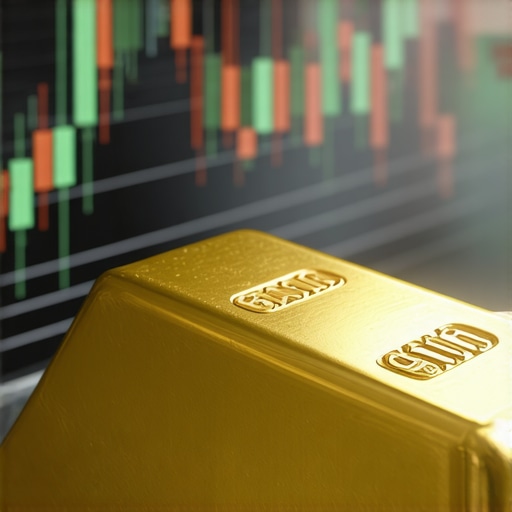Introduction to the Gold Supply Chain
The gold supply chain is a complex network that involves numerous stages, from mining to market. Understanding this intricate process is essential for investors who want to make informed decisions regarding their gold investments. In this article, we will explore the various components of the gold supply chain, breaking down each segment to offer valuable insights into how gold moves through the market.
The Stages of the Gold Supply Chain
Gold production begins with mining, where it is extracted from the earth. This stage can be further divided into various types of mining, including artisanal, small-scale, and large-scale operations. Each method has its own implications for supply and environmental sustainability. Investors must consider the type of mining when assessing potential investments in gold mining stocks, as these factors can influence both profitability and ethical implications.
Processing and Refining Gold
Once gold is mined, it must be processed and refined to achieve the desired purity. This stage involves several steps, including crushing, milling, and chemical treatment. The refining process is crucial for ensuring that the gold meets industry standards, which is particularly important for investors looking into gold coins or bullion investments.
Distribution and Retailing
After refining, gold enters the distribution phase, where it is sold to wholesalers, retailers, and ultimately consumers. This part of the supply chain is where market dynamics come into play, influencing gold prices based on demand and supply fluctuations. Investors should keep an eye on market trends and consumer behavior, as these can significantly impact gold prices.
Why Understanding the Supply Chain Matters for Investors
By comprehending the gold supply chain, investors can better assess risks and opportunities associated with their investments. The gold market is influenced by various external factors, including geopolitical events and economic conditions. Knowledge of how gold is sourced, processed, and sold empowers investors to make strategic decisions about their portfolios.
Moreover, understanding the supply chain can aid in evaluating the sustainability of investments. With the growing emphasis on ethical investing, recognizing the implications of gold sourcing can enhance an investor’s strategy and align it with personal values. Always consider the diversification of your portfolio by integrating gold investments in a balanced manner.
In conclusion, grasping the details of the gold supply chain equips investors with the insights necessary for navigating the complexities of the gold market. As you explore various investment opportunities, remember to keep these insights in mind for a more informed approach.
The Role of Gold in Economic Stability
Gold has been a cornerstone of economic stability for centuries, acting as a hedge against inflation and currency devaluation. Investors often turn to gold during times of economic uncertainty, making it a vital asset in diversified portfolios. Understanding the underlying factors that drive gold prices can help investors navigate market volatility and make informed decisions about their investments.
Geopolitical Factors Influencing Gold Prices
The geopolitical landscape plays a significant role in determining gold prices. Events such as wars, trade disputes, and political instability can drive demand for gold as a safe haven asset. Investors should remain vigilant about global events, as these can create fluctuations in demand and supply dynamics. For instance, recent tensions in various regions have led to increased interest in gold, pushing prices higher and influencing investment strategies.
Market Demand and Supply Dynamics
Understanding the demand and supply dynamics of gold is crucial for investors. Factors such as jewelry demand, industrial usage, and investment trends can impact the overall market. For example, the rising trend of gold-backed Exchange-Traded Funds (ETFs) has significantly influenced gold demand in recent years. Investors interested in gold ETFs should analyze how these funds affect the physical gold market and overall pricing.
Investment Strategies for Gold Investors
Developing a robust investment strategy is essential for anyone looking to invest in gold. Whether you choose to invest in physical gold, gold mining stocks, or ETFs, understanding the unique advantages and risks associated with each option is crucial.
Investing in Physical Gold
Physical gold, such as bullion and coins, offers tangible value but comes with storage and insurance costs. New investors should familiarize themselves with the best practices for purchasing gold and securing their investments. This includes understanding the purity levels, market prices, and reputable dealers to avoid potential scams.
Gold Mining Stocks: Risks and Rewards
Investing in gold mining stocks can provide exposure to the gold market without the challenges of storing physical gold. However, this approach comes with its own set of risks, including operational challenges and fluctuating stock prices. Investors should conduct thorough research and consider factors such as company performance and industry trends when investing in mining stocks. For more insights on evaluating such investments, check out this guide on gold mining stocks.
The Importance of Diversification in Gold Investments
Diversification remains a key principle in investment strategy. By spreading investments across various assets, including gold, investors can mitigate risks and enhance potential returns. Integrating gold into your portfolio can provide a buffer against market volatility, particularly during economic downturns. To learn more about effective diversification techniques, refer to this comprehensive guide.
In summary, understanding the complexities of the gold supply chain and market dynamics is essential for investors seeking to maximize their returns and manage risks effectively. By staying informed about geopolitical factors, demand trends, and investment strategies, you can navigate the gold market with confidence.
Understanding Gold Investment Options
When it comes to investing in gold, options abound, and each has its own unique characteristics. Investors can choose from physical gold, gold ETFs, gold mining stocks, and even gold mutual funds. Each option carries different risk profiles and potential returns, making it crucial to understand each one before making investment decisions.
Gold ETFs and Their Benefits
Gold Exchange-Traded Funds (ETFs) offer a convenient way to invest in gold without the need for physical storage. These funds track the price of gold and provide liquidity that physical gold cannot. Investors should consider the advantages of gold mutual funds as they can also provide diversification and professional management. Understanding how these instruments operate can lead to better investment outcomes.
Investing in Gold Mining Stocks
Gold mining stocks represent an indirect way to invest in gold. By purchasing shares in mining companies, investors can gain exposure to gold prices without having to deal with the logistics of physical gold. However, these stocks come with their own risks, such as operational issues and market volatility. For a deeper dive into this investment avenue, check out this evaluation of gold mining stocks.
Evaluating Market Conditions for Gold Investments
Understanding market conditions is fundamental for successful gold investment. Economic indicators such as inflation rates, interest rates, and currency strength can all influence gold prices. For instance, during periods of high inflation, gold often serves as a hedge, leading to increased demand. Thus, keeping an eye on economic forecasts can position investors to make timely decisions.
The Role of Central Banks in Gold Investment
Central banks play a significant role in the gold market by holding large reserves of gold. Their buying and selling activities can impact gold prices significantly. Investors should monitor central bank policies and actions, as these can provide insights into future market trends. For a detailed analysis of how central banks affect gold prices, consider reading this in-depth article.
Long-Term Outlook for Gold Investments
For many investors, gold is seen as a long-term investment. The historical performance of gold indicates that it often retains its value over time, especially during economic downturns. Therefore, incorporating gold into a diversified investment portfolio can be a wise decision. To understand the best strategies for maintaining gold holdings, explore these strategies for financial security.
In conclusion, navigating the gold investment landscape requires a solid understanding of various investment options, market conditions, and long-term strategies. By being informed and proactive, investors can position themselves to maximize returns while minimizing risks associated with gold investments.
Understanding Gold Investment Strategies
Investing in gold requires more than just understanding the various options available; it also necessitates strategic planning. Investors should consider their risk tolerance, investment horizon, and overall portfolio objectives. Diversifying your gold investments can mitigate risks and enhance potential returns. For instance, combining physical gold with gold ETFs can offer a balanced approach.
Risk Management in Gold Investments
Effective risk management is crucial in gold investing. Investors should regularly assess their portfolios to ensure alignment with market conditions and personal financial goals. Utilizing tools like stop-loss orders can help protect against significant losses during market downturns. For a thorough understanding of different investment avenues, explore the benefits of diversification with gold.
Analyzing Gold Demand Trends
Staying informed about gold demand trends is essential for making informed investment decisions. Factors such as geopolitical events, economic stability, and consumer trends significantly influence gold prices. For example, increased consumer demand in countries like India and China can lead to price surges. Investors should analyze these trends regularly to anticipate market movements.
Global Economic Factors Influencing Gold Prices
The global economy plays a pivotal role in shaping gold prices. Economic indicators such as GDP growth, unemployment rates, and inflation can signal changes in investor sentiment towards gold. In times of economic uncertainty, gold often becomes a safe-haven asset, leading to increased demand. To grasp these dynamics further, check out key takeaways on gold demand trends.
Utilizing Gold as a Hedge Against Inflation
Gold has historically been viewed as a hedge against inflation. As the cost of living rises, the purchasing power of fiat currencies can diminish, making gold an increasingly attractive investment. Incorporating gold into your portfolio can help preserve wealth and provide a buffer against economic instability. For a deeper dive into this topic, consider reading why gold is a powerful inflation hedge.
Building a Resilient Investment Portfolio
A resilient investment portfolio balances growth and security. Including a percentage of gold can enhance portfolio performance, particularly in volatile market conditions. Investors should regularly revisit their asset allocation to ensure it aligns with their long-term financial strategies. To develop a robust gold investment strategy, explore these best practices for financial security.
Final Thoughts on Gold Investment Strategies
In summary, investing in gold requires a comprehensive understanding of market dynamics, demand trends, and effective risk management strategies. By integrating gold into a diversified investment portfolio, investors can navigate economic uncertainties while potentially maximizing returns. Stay informed and proactive to capitalize on the unique benefits that gold investments can offer.
Frequently Asked Questions about Gold Investment
1. What are the benefits of investing in gold?
Investing in gold offers several benefits, including protection against inflation, portfolio diversification, and a hedge against economic uncertainty. Gold often retains its value over time and can provide stability in turbulent markets.
2. How can beginners start investing in gold?
Beginners can start by purchasing physical gold, such as coins or bullion, or investing in gold exchange-traded funds (ETFs) that track the price of gold. It’s important to research and understand the different investment vehicles available.
3. What are gold ETFs, and how do they work?
Gold ETFs are investment funds that trade on stock exchanges and invest primarily in gold bullion. They provide investors with exposure to gold prices without the need to own physical gold. Investors can buy shares of the ETF, which represent a fraction of the gold held by the fund.
4. Is investing in gold a good long-term strategy?
Yes, many financial experts consider gold a good long-term investment strategy. Historically, gold has maintained its value and has been a reliable store of wealth, particularly during times of economic instability.
5. How does gold perform during economic downturns?
Gold typically performs well during economic downturns as it is seen as a safe-haven asset. Investors often flock to gold when stock markets are volatile, which can lead to an increase in gold prices during these periods.
6. Can I invest in gold through retirement accounts?
Yes, investors can include gold in their retirement portfolios through self-directed IRAs that allow for gold investments. This option provides the benefits of gold investment while also enjoying tax advantages associated with retirement accounts.
7. What factors influence the price of gold?
The price of gold is influenced by various factors, including inflation rates, currency strength, interest rates, and geopolitical stability. Understanding these factors can help investors make informed decisions about when to buy or sell gold.
8. Is it better to buy physical gold or invest in gold stocks?
The decision between buying physical gold and investing in gold stocks depends on individual investment goals. Physical gold offers tangible value and a hedge against market fluctuations, while gold stocks can provide potential for higher returns but carry additional risks associated with the mining industry.
Authority Resources for Gold Investment
For further reading and in-depth knowledge about gold investment, consider visiting the following reputable websites and resources:
- World Gold Council – A leading authority on gold and its market dynamics, offering insights and research on gold investment.
- Investopedia – A comprehensive resource for financial education, including articles and guides about gold investing.
- Forbes – Provides expert opinions and analysis on gold investments and market trends.
- Kitco – A trusted source for live gold prices, charts, and market news related to gold investment.
- Bloomberg – Offers up-to-date news and analysis on economic factors affecting gold prices.
Conclusion
In conclusion, investing in gold presents a robust strategy for wealth preservation and portfolio diversification. Understanding various investment options, market dynamics, and risk management techniques is essential for making informed decisions. By leveraging the benefits of gold as a hedge against inflation and economic uncertainty, investors can enhance their financial security. Utilize the authority resources listed above to deepen your knowledge and stay updated on gold investment strategies.











This article really opened my eyes to the multilayered journey gold takes from extraction to the hands of investors. I’ve often focused solely on market prices or geopolitical tensions but hadn’t given much thought to the sustainability and ethical implications starting at the mining stage. Knowing whether gold comes from artisanal mining versus large-scale operations can impact both the environmental footprint and the long-term stability of supply — factors that definitely affect investment risk. I also appreciate the emphasis on refining and distribution phases, which underscore how much processing and market dynamics shape the final product investors buy. In my own experience, trying to evaluate gold mining stocks without this supply chain perspective felt like missing a big piece of the puzzle. I’m curious how others balance these layers of supply chain complexity with the need to act quickly on market shifts? Do you find it feasible to fully integrate sustainability considerations alongside financial metrics, or does that add too much complexity for day-to-day investment decisions? I’d love to hear strategies on how to effectively monitor and incorporate supply chain insights without getting overwhelmed.
This article sheds light on how deeply interconnected the entire gold supply chain truly is, and as someone who has been researching gold investment for a while, I find this perspective quite crucial. It’s interesting to note how each phase, from artisanal mining to refining and distribution, can influence not just the market price but also broader issues like sustainability and supply stability. Personally, I’ve been exploring how these factors impact long-term investment strategies, especially in considering ethical sources of gold, which are becoming increasingly important for responsible investing.
One challenge I see is balancing the urgency of market movements with the complexity of supply chain vetting—what’s your approach for staying informed without getting bogged down? Also, with rising consumer demand in countries like India and China, how do you think investors can best assess the risks tied to supply chain disruptions caused by geopolitical tensions or environmental regulations? I’d love to hear others’ experiences in navigating these nuances while trying to keep their portfolios resilient and aligned with their values.